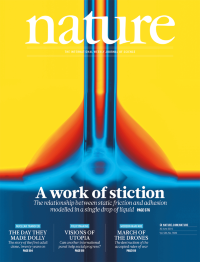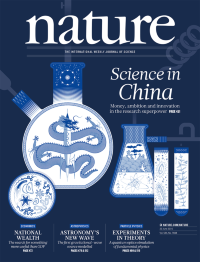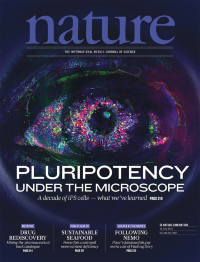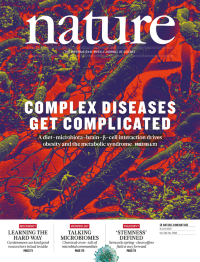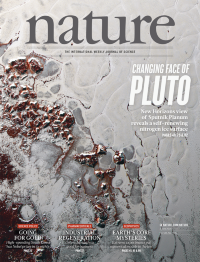Volume 534
-
No. 7609 30 June 2016
The sum of 390 sequential 1-MB photographs of an aqueous electrolyte drop in motion across a switchable boron nitride surface. Stiction, or static friction, is the force required to persuade an object to start sliding across a surface. It is technologically important in devices with moving parts in contact, but is not well understood. Stijn Mertens et al. describe an inorganic model system for the study of the relationships between surface wetting, stiction, adhesion and lubrication. The system is a hexagonal boron nitride monolayer that can be electrochemically switched by intercalation of hydrogen between a corrugated and a flat morphology. The change in the surface structure of the boron nitride alters the adhesion and its balance with stiction of an aqueous drop sliding across the monolayer. The work of adhesion increases in going from the flat to the corrugated surface, whereas the stiction threshold does not change significantly. Thus the authors make a quantitative connection between the macroscopic properties of stiction and adhesion as a result of structural control at the atomic scale.
-
No. 7608 23 June 2016
This special issue of Nature looks at the state of science in China today and the prospects for the future. We chart the rapid rise of Chinese research (page 452) and profile ten of the nations leading scientists (page 456). One area in which the country is vying to lead the world is DNA sequencing, and an article on page 462 shows that it plans to dominate precision medicine too. In a Comment article, Wei Yang, head of Chinas Natural Science Foundation, argues that China needs to improve the quality, integrity and applicability of its basic research (page 467). And Douglas Sipp and Duanqing Pei argue that, contrary to common perceptions, China offers lessons for other nations in how to govern ethically sensitive research in the life sciences (page 465). Cover: Jasiek Krzysztofiak/ Nature
-
No. 7607 16 June 2016
Induced pluripotent stem (iPS) cells were supposed to herald a medical revolution. The hope was that a patients skin, blood or other cells could be reprogrammed as iPS cells, and then used those to grow liver cells, neurons or whatever was needed to treat their disease. Ten years after their discovery, iPS cells are still promising, but the emphasis has shifted from regenerative medicine to modelling and investigating human diseases and drug screening. In a News Feature this week we chart the developments of the past decade and look at the current and predicted trends in iPS cell research. Cover illustration by Andy Potts.
-
No. 7606 9 June 2016
A scanning electron microscopy image of faecal bacteria. Changes to gut microbiota, and altered faecal short-chain fatty acid concentrations, have been associated with obesity, insulin resistance and the metabolic syndrome, but no causal links have been established. Gerald Shulman and colleagues show that a gut microbiotanutrient interaction increases acetate production in rodents on a high-fat diet. This leads to activation of the parasympathetic nervous system � the part of the nervous system that controls subconscious� operations such as heart rate and digestion � which in turn promotes increased glucose-stimulated insulin secretion, ghrelin secretion, hyperphagia and obesity. Cover: SEM by Morven Graham & Xinran Liu, pseudo-colour by Fred Gorelick.
-
No. 7605 2 June 2016
Sputnik Planum on Pluto, as seen by NASAs New Horizons spacecraft. New Horizons has revealed fascinating details of the surface of Pluto, including a vast ice-filled basin known as Sputnik Planum, which is central to Plutos geological activity. Much of the surface of Sputnik Planum, consisting mostly of nitrogen ice, is divided into irregular polygons that are tens of kilometres in diameter and whose centres rise tens of metres above their sides. Two papers in this issue of Nature analyse New Horizons images of this polygonal terrain. Both conclude that it is continually being resurfaced by convection, but arrive at contrasting models for the process. Alexander Trowbridge et al. report a parameterized convection model in which the nitrogen ice is vigorously convecting, ten or more kilometres thick and about a million years old. William McKinnon et al. from the New Horizons team show that sluggish lid convective overturn in a several-kilometre-thick layer of solid nitrogen can explain both the presence of the cells and their great width. Photo: NASA/Johns Hopkins Univ. Applied Physics Lab./Southwest Research Inst. Image composition and processing by P. Schenk & P. Engebretson.

